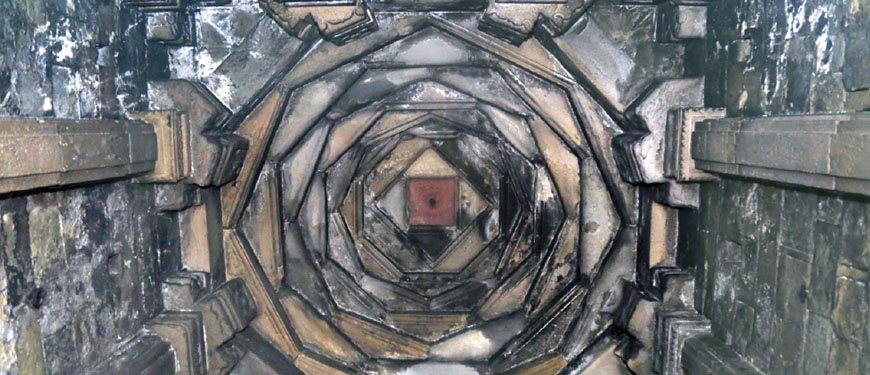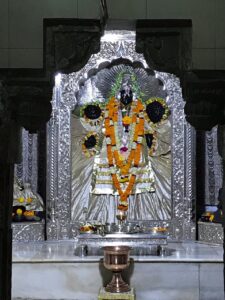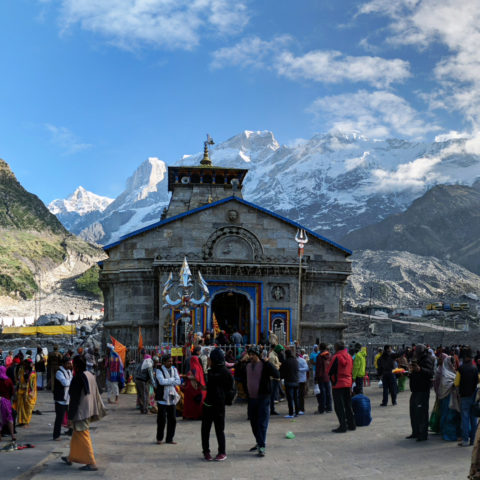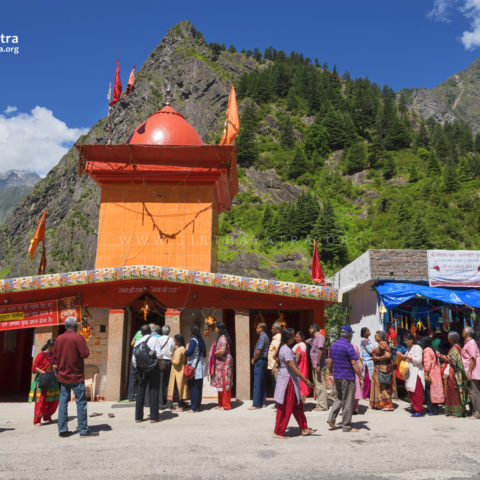
Bharat Mandir in Rishikesh of Uttarakhand is the most ancient and most important temple in Rishikesh. The presiding Deity of Bharat Mandir is Sri Hrishikesha Narayana. The town of Rishikesh is named after the name of this Deity.
Rishikesh is the Yoga Nagari – the city of Yoga but within the so-called glamour of this city and its contemporary ashrams, lie hidden the ancient temples which are forgotten and not visited by devotees at all. You just visit Rishikesh, attend the ganga-arati, walk around the Lakshman Jhula and the Ram Jhula, gobble up some snacks and just go away without touching the actual essence of Rishikesh.
Bharat Mandir is the oldest temple of Rishikesh
Visit to Rishikesh is complete only when you visit these few ancient temples which are glorified in the pages of history and are limited only to the books. One such temple is Bharat Mandir. The town of Rishikesh is as old as Bharat Mandir. Sri Hrishikesh Narayana is the ruling Deity of Rishikesh. Bharat Mandir is one of the four ancient temples of Rishikesh, other three being Raghunath Temple, Shatrughna Temple, Lakshmana Temple.
Bharat Mandir is in the heart of Rishikesh, not far from the banks of River Ganga. It can be accessed either on foot or by auto. The temple is quite known amongst the locals. The temple is glorified exclusively in the Kedar Khand of Skanda Purana. The temple is also mentioned in Varaha Purana, Mahabharata and Narasimha Purana.
The origin of Sri Hrishikesha Narayana
During the seventeenth Manavantara, there was a sage named Raibhya Rishi, a great friend of Bharadwaja Muni. He had two sons Arvavasu and Puravasu. Due to some misunderstanding, Bharadwaja Muni cursed Raibhya Muni. To relieve himself of the sin of cursing a brahmana, Bharadwaja Muni left his body who was later brought to life by Arvavasu Muni, the son of Raibhya Rishi.
 Raibhya Rishi came to Rishikesh and performed tapasya here, on the banks of River Ganga to please Lord Vishnu. Pleased by his strict observation of the vows, Lord Narayana appeared and gave him darshan, seated on the branch of a nearby mango tree. Some devotees say that Lord Narayana leaned against the Mango tree and gave darshan.
Raibhya Rishi came to Rishikesh and performed tapasya here, on the banks of River Ganga to please Lord Vishnu. Pleased by his strict observation of the vows, Lord Narayana appeared and gave him darshan, seated on the branch of a nearby mango tree. Some devotees say that Lord Narayana leaned against the Mango tree and gave darshan.
Raibhya Muni requested the Lord to liberate him from the illusory energy. Since the sage conquered his senses and worshiped the Lord, the Lord blessed Raibhya Rishi that He would stay here in the form of Hrishikesh Narayana and the place will be known after Him. Hrishikesh means one who is the master of senses. In Bhagavad-gita, Arjuna addressed Lord Krishna as Hrishikesh.
Due to the weight of Lord Narayana, the tree bent and hence this place also came to be known as Kubjamrika Kshetra. The Narasimha Purana states that this place is very dear to Lord Narayana. Elsewhere this place is glorified as Agni Tirtha due to Agni Deva performing tapasya here to be relieved from the curse of Lord Shiva.
In the Satya-yuga, Maharaja Son Sharma performed tapasya here and had darshan of Lord Narayana. He requested Lord Narayana to show His illusory energy (maya) to him, to which Lord exhibited His maya to Maharaja Son Sharma. The Kunda where Lord Narayana showed His maya, came to known as Maya Kunda.
Bharat Maharaja, the son of Maharaja Dushyant had performed ashvamedha yajna in this place. Bhakta Prahlada a great devotee of Lord Narasimha, worshiped Sri Hrishikesha Narayana in Bharat Mandir, enroute Badrikashrama. Pandavas had darshan at Bharat Mandir after which Lomasha Rishi had advised them to carry only minimum things to carry to Badrikashrama.
In the earlier days, the temple was opulent and grand, but which grand temple has been spared by the Muslims? The temple was brought down many times and rebuilt always. The current temple structure was constructed by Maharaja Yashwant Singh of Nabha Kingdom.
The Sri Yantra in Bharat Mandir
During the vikrama samvat 846, Adi Shankaracharya did punah pratishsthapana of Lord Hrishikesh Narayana on the Vasanta Panchami day. He also installed a Sri Yantra above the Lord, within the temple vimana gopura. This Sri Yantra was installed to harmonize the power of five Vedic methods of worship. Its installation was carried out mystically and distinctively. It was meant only for few sadhakas for their spiritual upliftment.
Due to this, only strict followers of Sanatana Dharma are allowed inside the temple after observing the necessary purificatory processes. This Sriyantra is very grand and splendid. It bestows the power, opulence, prosperity and success to its worshiper.
Anyone who performs 108 pradikshinas of Bharat Mandir on the Akshaya Tritiya Day, has one’s desires fulfilled. He also acquires the punya of having darshan of Lord Badrinarayana.

The Vigraha of Sri Hrishikesh Narayana in Bharat Mandir
The vigraha of Sri Hrishikesh Narayana is very beautiful and enchanting. He is tall and handsome. The vigraha is made out of shaligrama shila and has four hands. Lord Narayana is holding shanka, chakra, gada and padma. In the altar one can also have darshan of Sri Varahadev. In the prakara of the temple, one can have darshan of Sri Pataleshwar Mahadev, Bhadrakali and Suryadeva.
Best time to visit Bharat Mandir
Devotees can visit Rishikesh all throughout the year. The ideal time to visit is October and November, when the weather is really pleasant. Vasant Panchami is generally crowded. Otherwise, the temple is generally free from the visitors and the tourist crowd.
How to reach Bharat Mandir?
The best way to travel to Bharat Mandir without any hassles, is to travel with Tirtha Yatra on the Char Dham Yatra or Pancha Badri Yatra. All the arrangements shall be taken care by Tirtha Yatra.
If you wish to travel on your own, here is the way:
By Air: the nearest airport is the Jolly Grant Airport. From there, one may hire a taxi to reach Bharat Mandir.
By Rail: Rishikesh has a railway station, which is connected with other major railway stations in the country.
By Road: Rishikesh is well connected with Roadways from New Delhi, Dehradun, Bijnor and other major cities.
1












Comment On Bharat Mandir, Rishikesh
K V Mohan
Its good message